|
|
Home →
Survival →
Food and Cooking
Cooking with Rocks in
a Birch Bark Wok
Chris Gilmour & Laura Alward
Photographs by Chris Gilmour
|
Have you ever wondered how you would go about
cooking your foraged or hunted food if you were out in the woods without any
modern conveniences? Or maybe you’d like to learn to travel a little lighter
leaving your bulky aluminum and cast iron pots and pans behind. Both of
these questions sparked my interest and have led to many fun experiments in
primitive cooking.
After doing some research and forming our plan it was time to get busy
finding appropriate materials. Our goal was to cook a typical stir fry
(although all the veggies were store bought we pretended they were a mixture
of wild greens, fresh picked mushrooms, and some recently snared rabbit
meat) using no modern utensils and thus foraging most of our materials from
the near by woods.
We started by finding a recently fallen birch tree that our landlord had cut
down for firewood. The tree was in good health and the bark relatively
blemish free. This made it much easier to peel off without
puncturing/tearing holes as we went. It was fall time and after scoring the
pieces we wanted with a pocket knife, they peeled off relatively easily. The
White Birch (Betula papyrifera) tree has several distinct layers to
its bark.
We found the two inner layers just under the very papery white exterior to
be quite strong, durable and perfect for our task. Next we went about
gathering round rocks slightly smaller than our fists from the highlands of
our property. When gathering rocks to place in a fire it is very imperative
to collect them away from water sources. A rock with too much moisture in it
will explode in a fire!! |
|
|
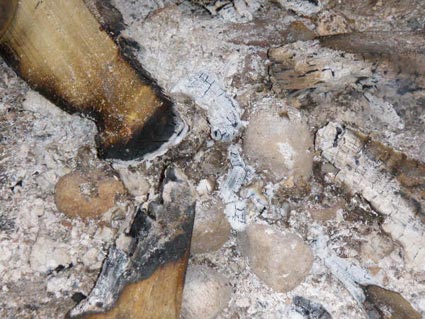 |
After using our bow drill kit to get a
good fire going (we built the fire up fairly large to create a good
coal base for heating the rocks, and to give us lots of room to
place the rocks near the center of the fire) we prepared our
primitive “wok”. We placed two branches approximately four inches in
diameter, a foot apart from each other. We then layered two
rectangular pieces of our bark in a “X” formation across the
branches. Nearby we had a third piece of bark similar in size and
shape to act as a lid. |
|
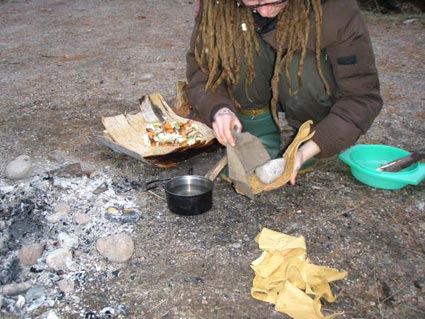 |
Once the rocks were heated, (we left
ours for about one hour in the well developed coals), we used two
wooden sticks, one with a “Y” at the end to begin removing rocks
from the fire.
It is very, very important at this stage in the process to make
sure you have a cloth to wipe the rocks off with in order to remove
mildly carcinogenic char and more important any little fragments of
rock that may have began to come loose while the rock undergoes
drastic temperature changes. We used a piece of leather to hold the
rock while wiping it down with a cloth. Failure to remove any little
fragments of rock could result in a chipped toothed when it comes
time to eat your wild meal. Not a fun scenario in a wilderness
setting, or any other for that matter! |
|
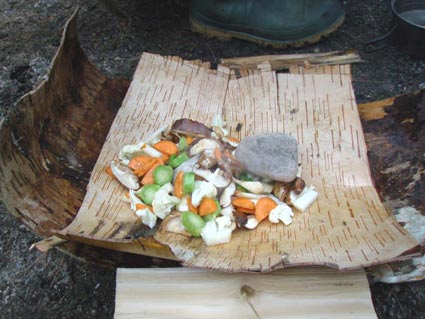 |
We added the rocks one at a time,
waiting a short while before putting in the next one. It is amazing
how long a well heated rock will hold its heat for. I once heated a
rock in a fire and stuck it in my sleeping bag for extra warmth on a
cold spring night. Ten hours later as I watched the morning sun rise
it was still hot to the touch! |
|
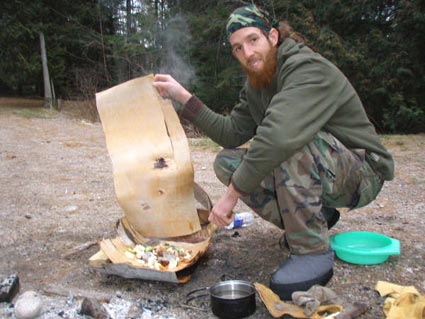 |
After a few rocks were added we poured
in a very small amount of water to create a steamer. Then we covered
the wok with our lid and let it do its magic. Every couple of
minutes we lifted the lid to give it a stir and scrape the rocks. If
it seemed like the cooking was slowing down we would add another
rock to the mix.
|
|
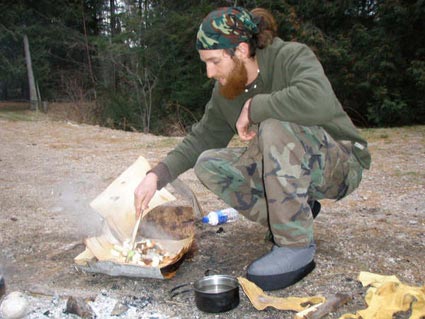 |
Twenty minutes later we were ready to
eat. Well, almost ready, first we had to break a couple straight
dead branches for some chop sticks and remember to give thanks for
the great food and all the lessons that came along with it.
The best part of the whole experience... No dishes! When you're done
just toss all your utensils right into the fire! |
|
|
|
|
|